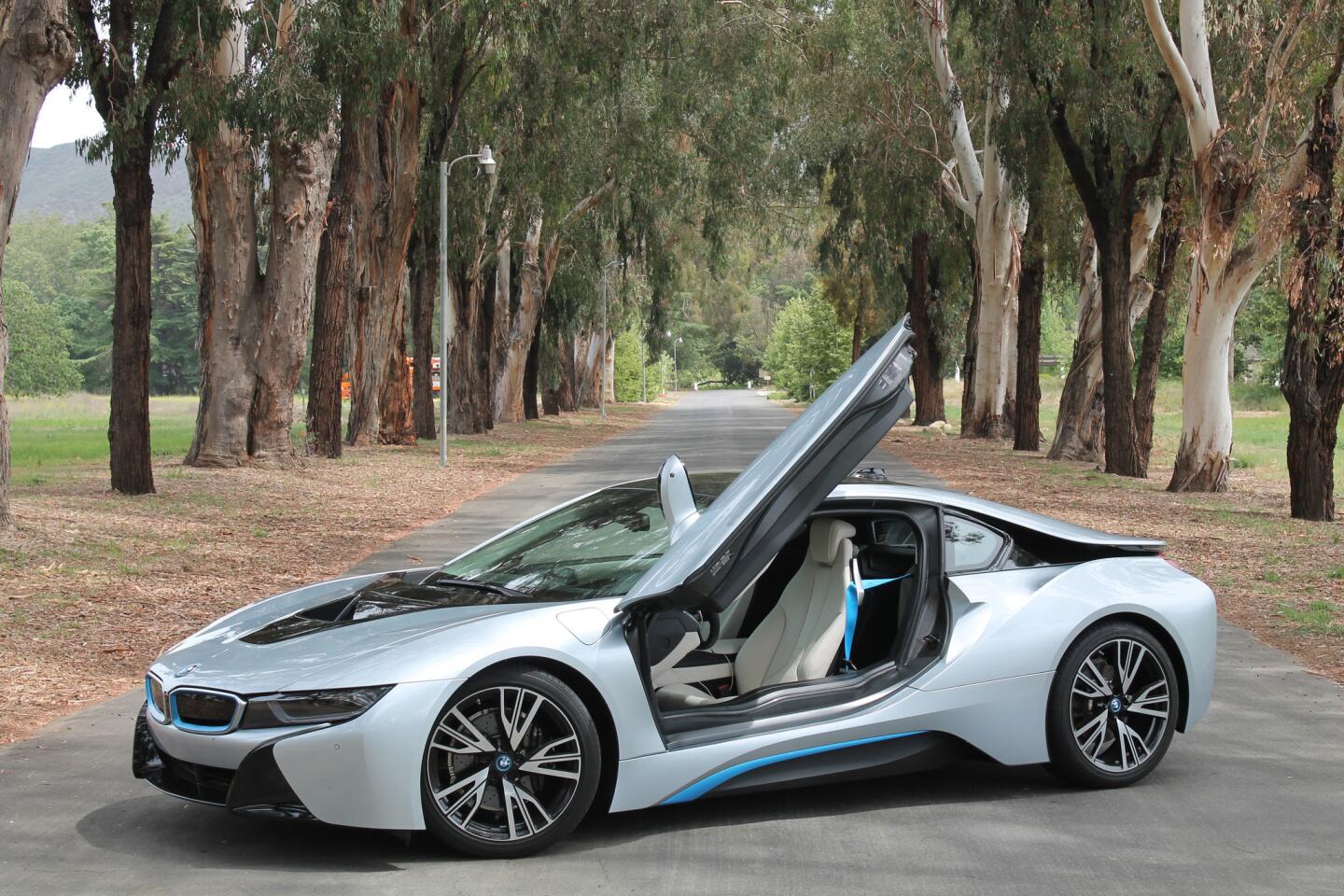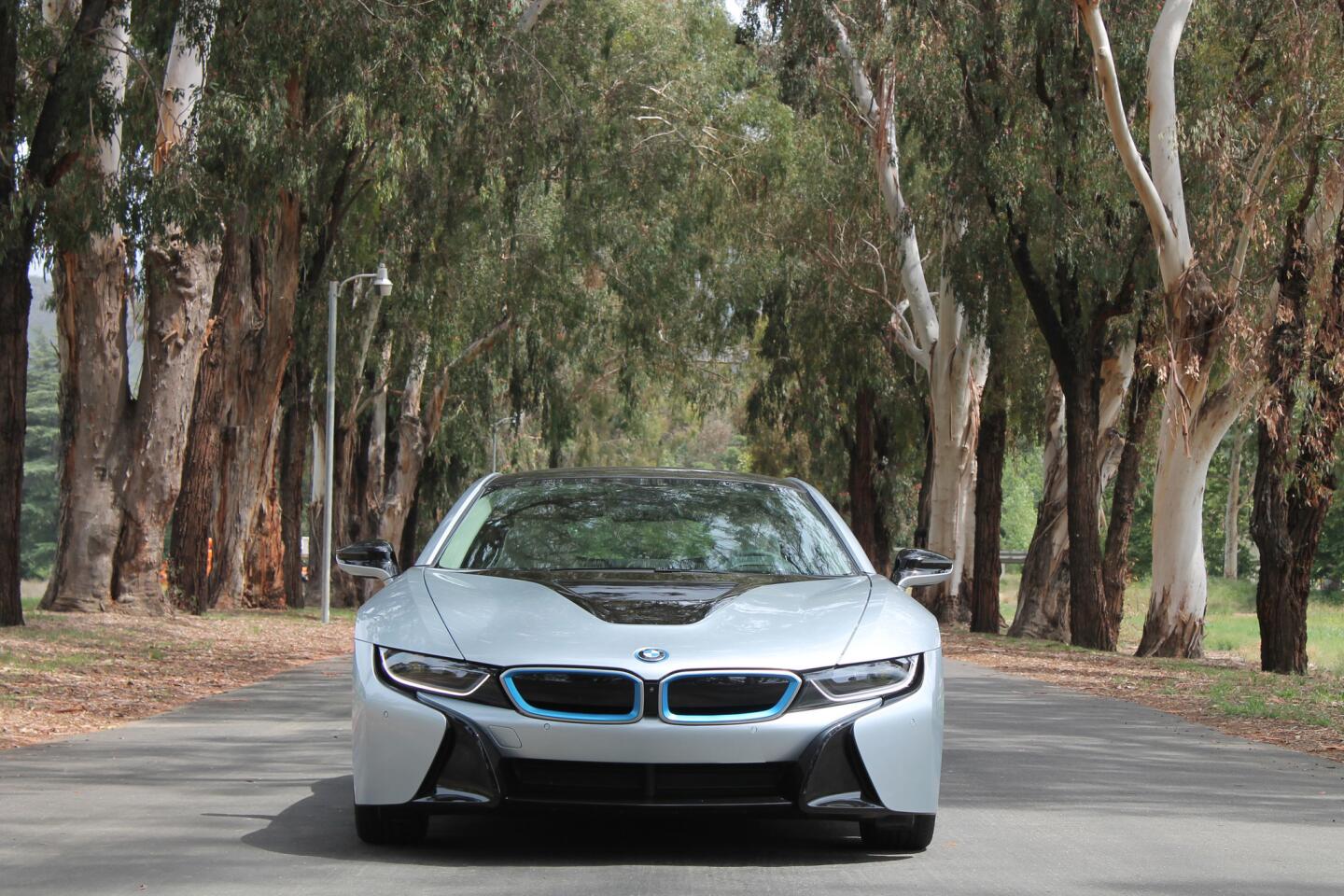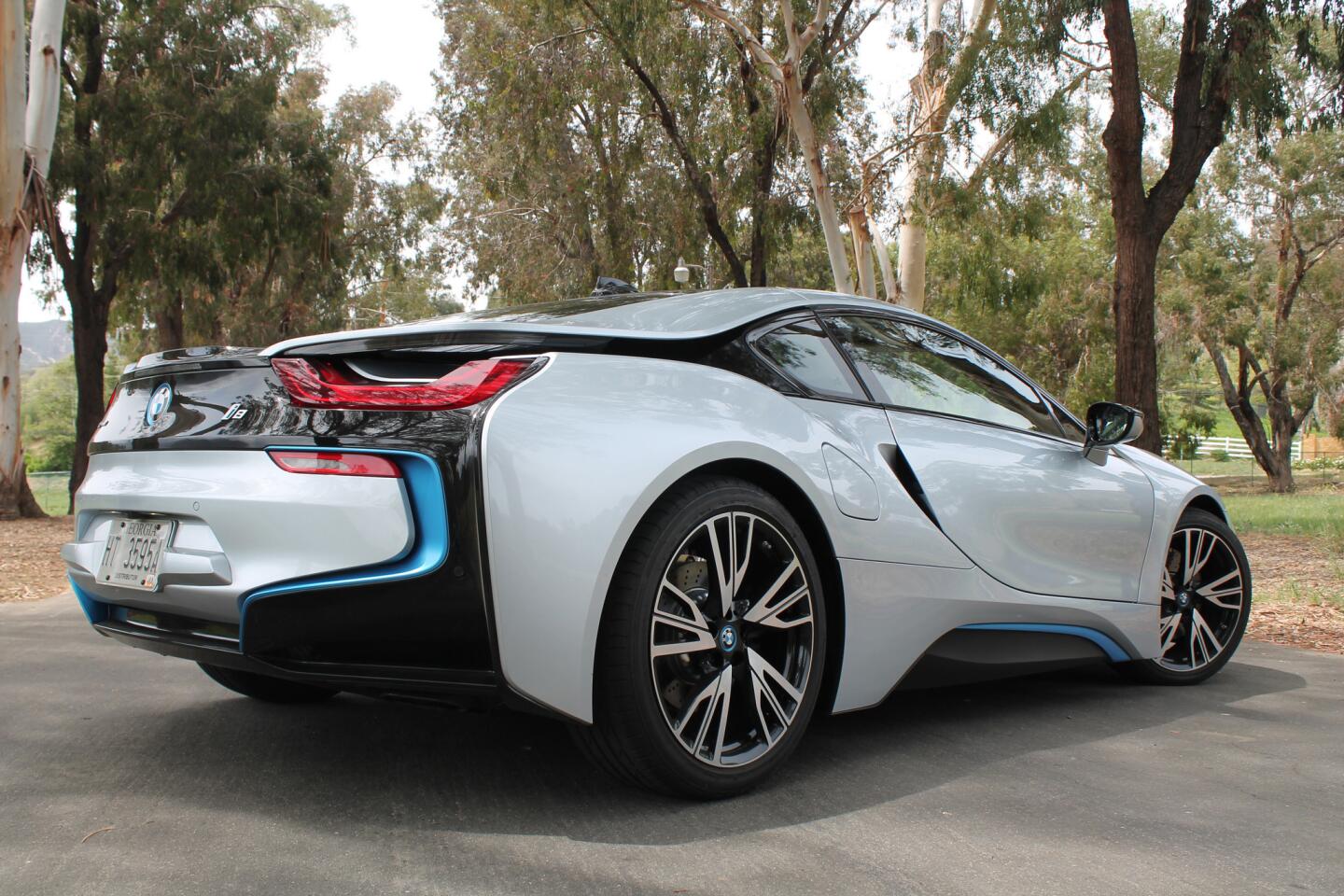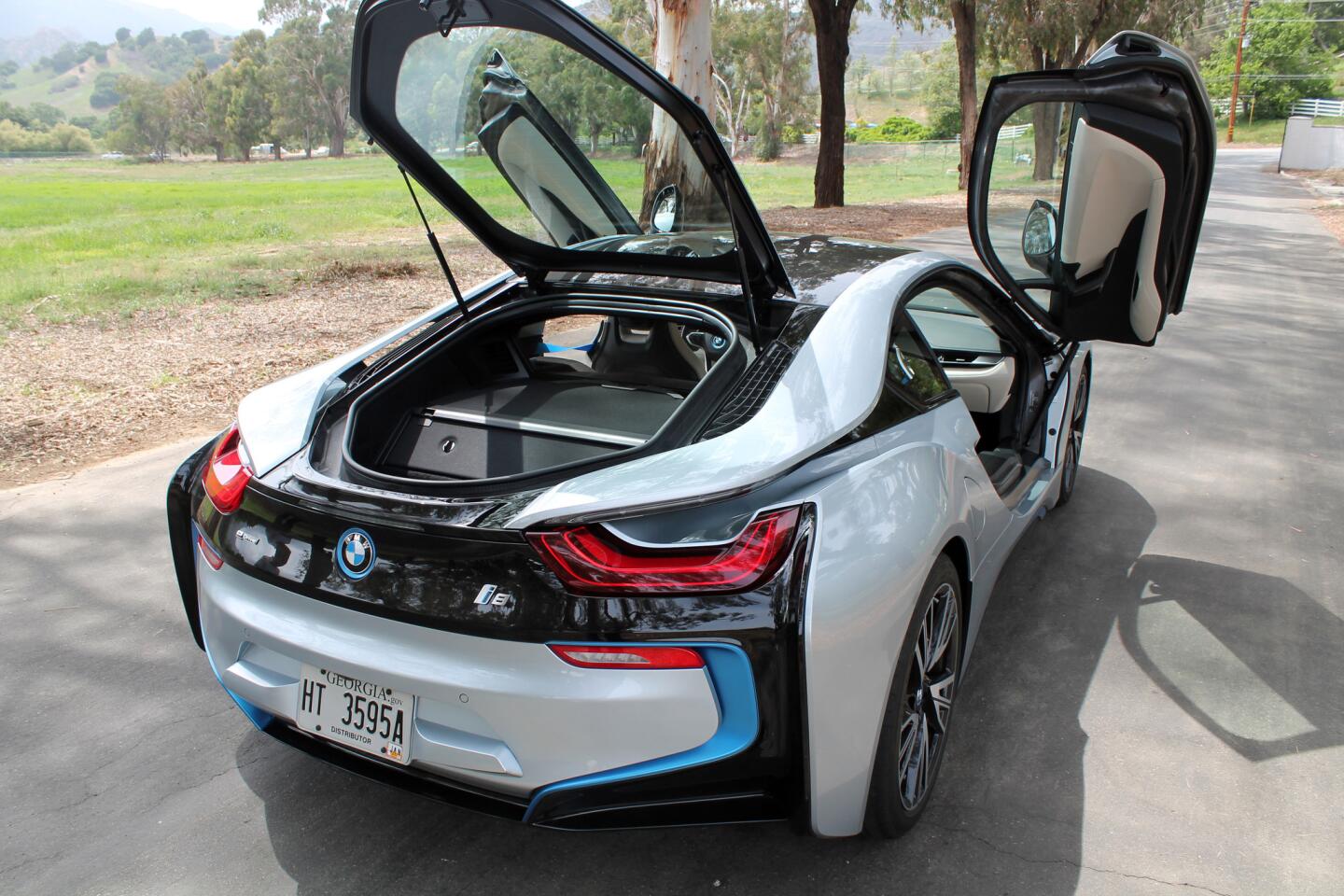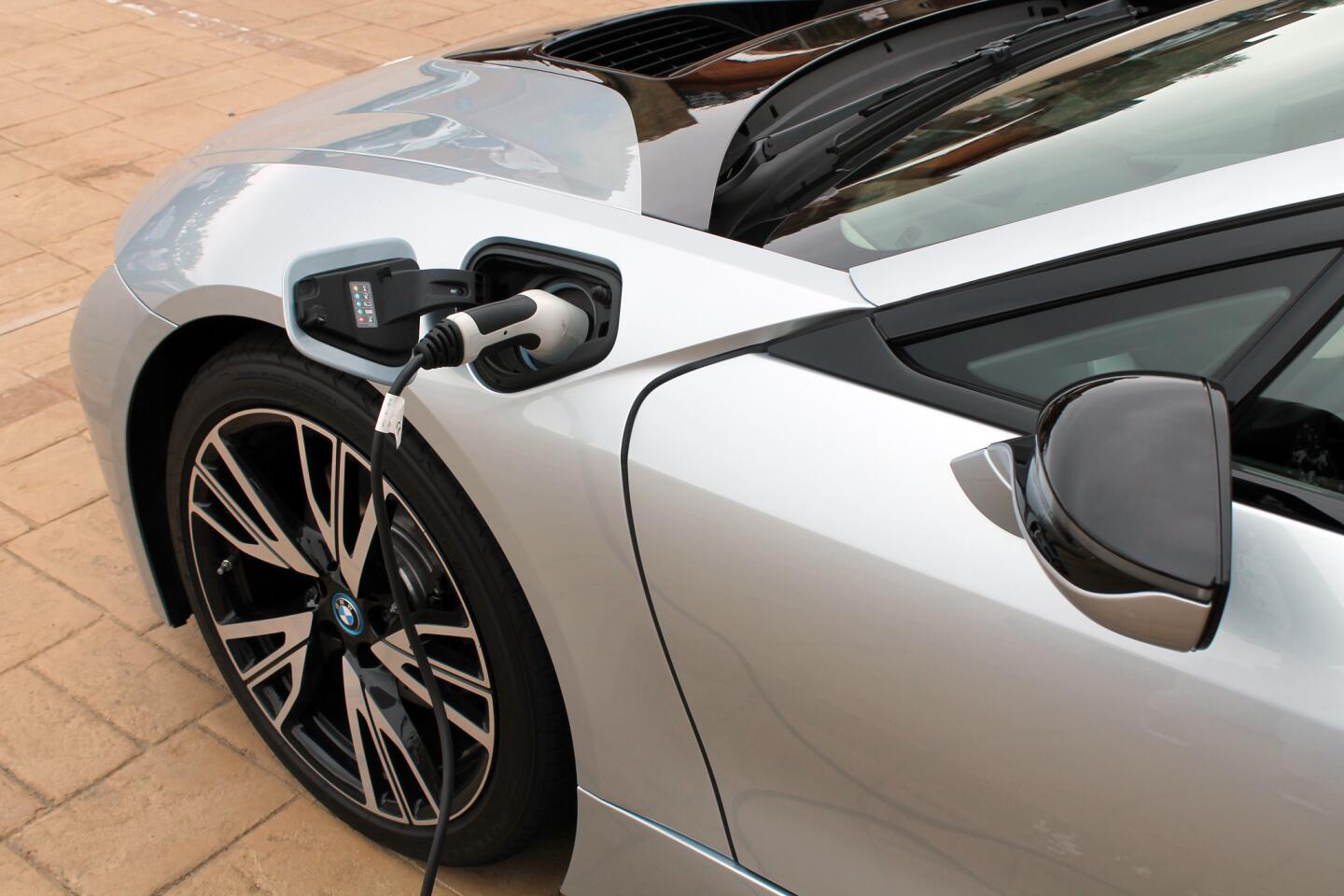2014 BMW i8 plug-in hybrid: High performance but with a conscience
Attention, eco-chic speed freaks: Set aside your Teslas; you have a new toy to covet.
The 2014 BMW i8 plug-in hybrid and the all-electric i3 are the first offerings from the automaker’s new i subbrand. Equal parts sex appeal and efficiency, the cars combine electrification with lightweight construction and eye-catching designs. We recently spent a day in the i8, a 357-horsepower, all-wheel-drive coupe with wing-like doors that open upward and a body that will excite anyone with a pulse.
This is no Leaf or Volt. The i8 sells for $136,000. But it’s not a Porsche 911 or Audi R8 either — though it costs about as much. This car promises high performance, but limited by a conscience.
At the press launch last week in Santa Monica, Henrik Wenders, i8 project manager, sought to clearly distinguish the i8 from such high-end sports cars.
“If you want to improve your lap time on the track, buy another car. It’s an i, not an M,” he said, referring to BMW’s performance line.
This means BMW refrained from programming the car as aggressively as it could have.
“We tried to find the perfect balance between efficiency and dynamism,” Wenders said.
The search for that balance begins with the drivetrain. The i8 is powered by two sources.
Up front, a small electric motor powers the front wheels. In back, nestled above the rear wheels, is a turbocharged, 1.5-liter, three-cylinder engine hooked up to a six-speed automatic transmission.
The electric motor is the same one that powers the i3 all-electric city car, while the gas engine is loosely based on the unit in the new Mini Cooper.
This pairing nets 357 total horsepower and 420 pound-feet of torque. BMW says the duo move the rear-drive i8 from zero to 60 mph in 4.2 seconds, on its way to a 75-mph top electric-only speed, and an electronically limited 155-mph true top speed.
How that power gets to the wheels depends on which of three driving modes is engaged. The default setting is Comfort, which uses the electric motor at speeds up to 37 mph before adding in the power from the gas engine.
EcoPro is more conservative and also limits how much power is sucked up by functions such as the AC. For pure electric driving, there’s the eDrive button, which gives you about 22 miles of range.
But the best way to play is with the i8 in its Sport setting. That’s also where the car does its most efficient recharging. Sport mode tightens up the steering and adaptive suspension, quickens the transmission shifts, makes the throttle more eager and lets the electric motor kick in earlier.
It also pipes the engine’s divine whir into the cabin — in a way the company calls “augmented.” BMW prerecorded the i8’s best engine noises. When driven in Sport mode, the car plays this sonic mixture through its speaker systems.
Of course, this is ridiculous and fake, and represents everything that’s wrong with the future of motoring. But it sounds so good that you feel dirty and cheap for loving it.
The rest of the driving experience, especially in Sport mode, is quite real. With the 216-pound lithium-ion battery pack mounted low and longitudinally between the passengers, the i8 has a center of gravity similar to your average bathtub. Scooting around some canyons translates into little body roll.
At speed, the i8 holds tightly to the road and feels neutral in the corners. When the turns tighten up, the BMW feels lighter than you’d expect, given that it weighs about as much as a Toyota Camry.
But these slow apexes also tied up the i8, thanks largely to the narrow tires BMW put at the front of the car. Though they were the optional performance set, this rubber was too focused on being efficient and gave up its grip on the road too easily.
Also, though the six-speed automatic transmission’s manual mode and paddle shifters inspire quick, throttle-blipping shifts from the little engine behind you, the car will automatically upshift around 6,500 rpm and deny you downshifts if the engine is revving too high.
Aggressive driving in the Malibu canyons left us wishing for that Sport+ mode that comes on many other BMWs, though admittedly, we drove it harder than most of its target buyers will. The steering felt one shade too light for the desired mid-corner confidence, and the throttle didn’t respond quickly enough for fast exits out of turns.
In regular daily driving, the i8 is eminently refined. Duck under the gull wing-style open door and climb over the wide sill into a cabin that looks similar to any new BMW — just one that’s a lot harder to get into and out of.
The cabin is comfortable and quiet, with the only audible intrusion coming from the delicious (fake) engine sound and the front tires giving up their grip. There’s plenty of room in the front seats, but almost none in the rear.
The car’s lithium-ion batteries recharge in 3 to 5 hours via a 110-volt outlet and in 1.5 hours with a 220-volt plug, BMW said. Kick the i8 into Sport mode, and the engine also acts as a generator while you drive. We saw it fully recharge a depleted battery in about 30 minutes of driving.
Plug-in hybrid or not, this car’s biggest draw is its styling. BMW wrapped a dramatically futuristic body around the mid-engine proportions of high-priced exotics.
One particular highlight is the character line that starts below the doors and sweeps up above the rear wheels and ends at the taillight. Look closely and you’ll see that at this intersection, the panel above the rear wheels has a fin shape to it. And the roofline that slopes down to meet this panel actually doesn’t touch it, creating a small tunnel of space for air to flow over the car.
Throw in the doors that open upward, and you have a car that attracts gobs of attention. Expect surreptitious camera-phone shots at stoplights, low-speed drive-bys and outright gawking.
The coupe goes on sale this September, and the future probably holds a convertible and possibly a retuned high-performance version later.
The i8’s conspicuous non-consumption of fuel and its capable but approachable demeanor should make it possible for BMW to sell its goal of 20,000 to 30,000 i8s, globally, over its life span. Tesla is on track to sell around 20,000 of its $70,000-$93,000 Model S cars in the U.S. for 2014 alone.
Even with a $136,000 price tag, BMW should be able to attract a crowd similar to the Tesla set: moneyed Silicon Valley and Westside denizens who want their speed to come in a form that still says, “I care.”
